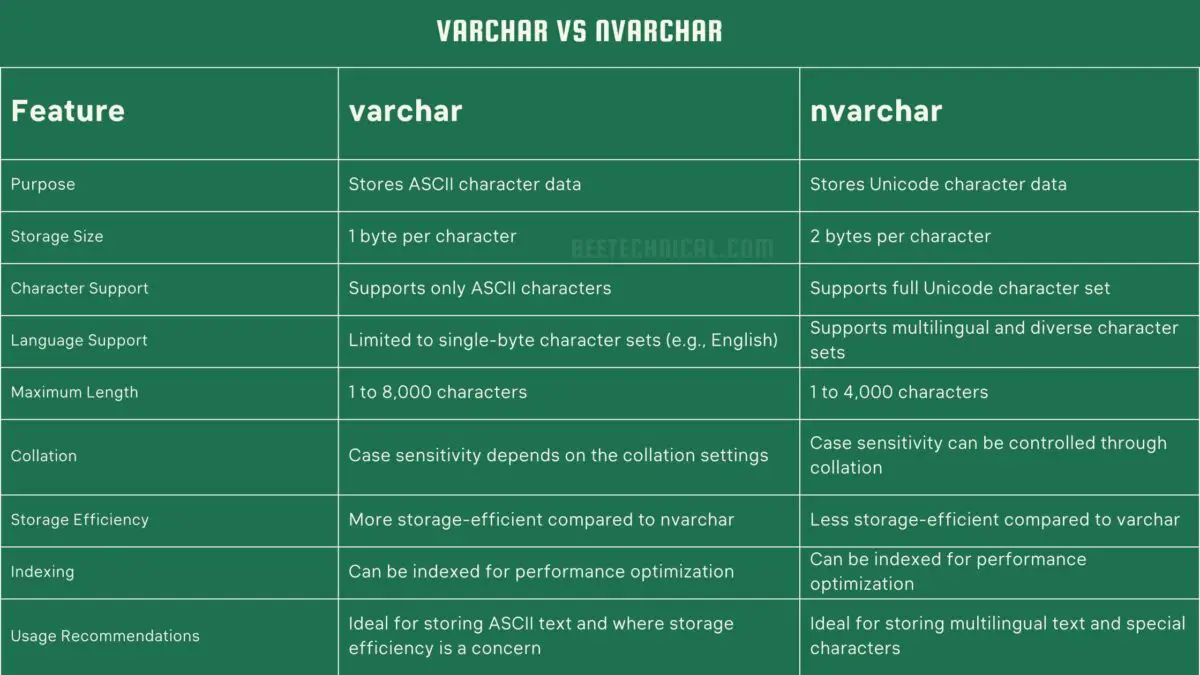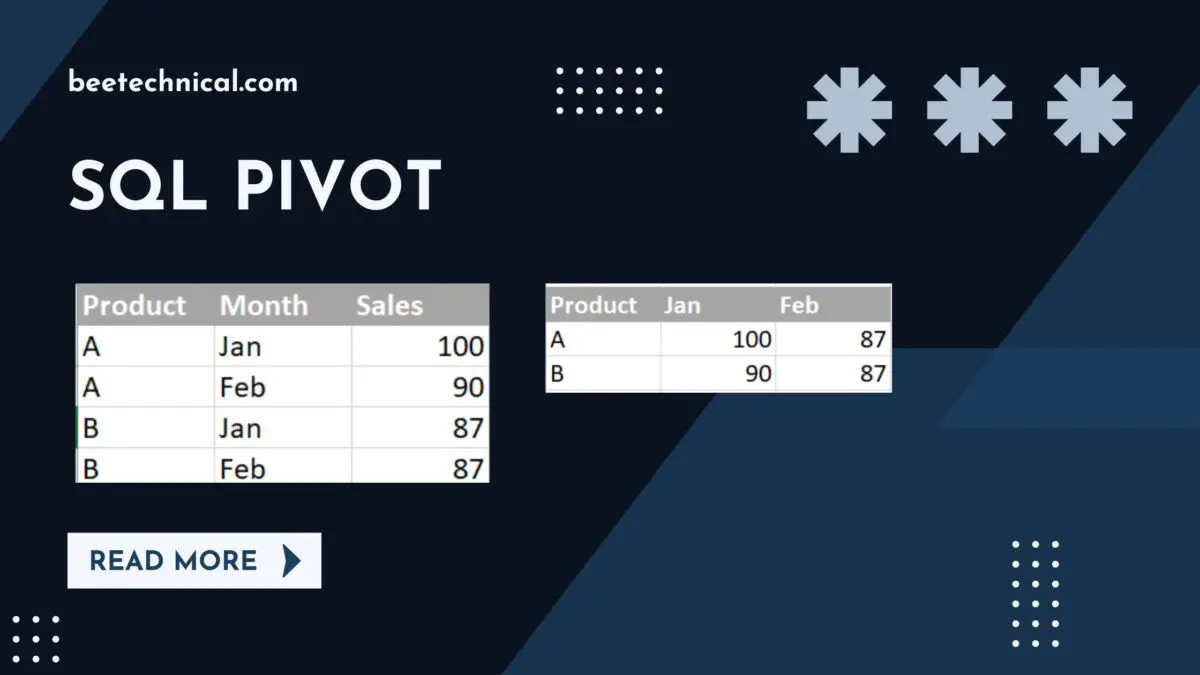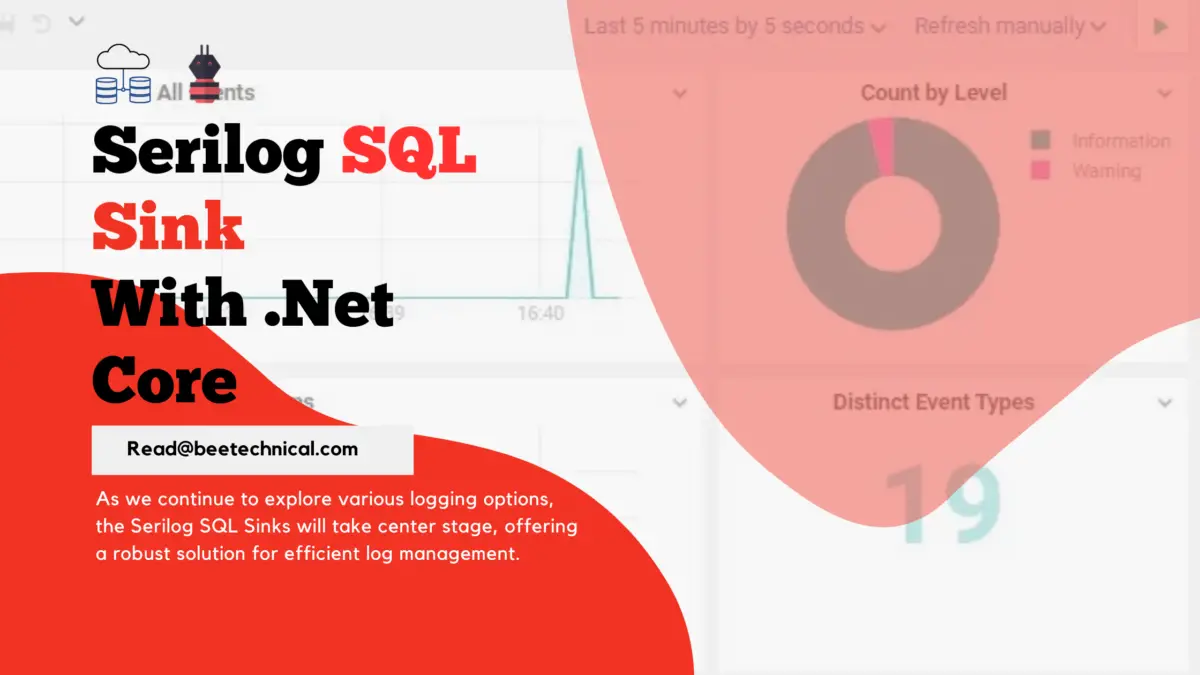We can utilize CTE in SQL Server when dealing with recursive queries, complex data manipulation, code reusability, query optimization, and improving the readability and maintainability of SQL queries.
Common Table Expressions (CTEs) in SQL Server are useful in several scenarios, including:
- Recursive Queries: CTEs are commonly used to perform recursive queries, where a query refers to itself multiple times to retrieve hierarchical or nested data, such as organizational charts, file system structures, or product categories with multiple levels.
- Complex Data Manipulation: CTEs can simplify complex data manipulation tasks, such as filtering, sorting, and joining data from multiple tables, by breaking down the logic into smaller, more manageable steps within the CTE.
- Code Reusability: CTEs allow you to define a temporary result set that can be referenced multiple times within the same query, making it convenient for code reusability and reducing redundancy in SQL queries.
- Query Optimization: CTEs can improve query performance by materializing intermediate result sets and reducing the need for multiple subqueries or temporary tables, resulting in more efficient and optimized SQL queries.
- Readability and Maintainability: CTEs can enhance the readability and maintainability of complex SQL queries by providing a clear and organized structure, making it easier to understand and modify the query logic.
What is CTE in sql server?
CTE stands for Common Table Expression, which is a temporary named result set that can be used within a SQL statement in SQL Server. It allows you to define a query that can be referenced multiple times within a larger query, making complex queries more organized and efficient.
CTEs are similar to views in SQL Server, but they are defined and used within a single query and do not persist in the database like views.
CTE Syntax in SQL Server
WITH cte_name (column1, column2, ..., columnN) AS (
-- CTE query definition here
)
SELECT column1, column2, ..., columnN
FROM cte_name
-- Additional query or JOINs, WHERE, GROUP BY, ORDER BY, etc.
Explanation of the syntax:
WITH: This keyword is used to define the start of a CTE in SQL Server.cte_name: This is the name given to the CTE, which can be any valid identifier. It is used to refer to the CTE later in the query.(column1, column2, ..., columnN): This is an optional list of column names that can be specified after thecte_name. It defines the column names and their data types for the CTE.AS: This keyword is used to specify the beginning of the CTE query definition.-- CTE query definition here: This is the actual SQL query that defines the CTE. It can be a SELECT, INSERT, UPDATE, DELETE, or any other valid SQL statement.SELECT column1, column2, ..., columnN: This is the main query that references the CTE. It can select columns from the CTE or join it with other tables, apply filters, group by, order by, and perform other operations as needed.
Note that CTEs are typically used in conjunction with the SELECT statement, but they can also be used with other DML (Data Manipulation Language) statements like INSERT, UPDATE, and DELETE in SQL Server. CTEs provide a concise and readable way to define temporary result sets within a query, improving query performance and code maintainability.
Example of CTE in SQL Server
Consider a scenario where you have a table called Employees with the following structure:
Employees Table: EmployeeID | EmployeeName | ManagerID -------------|---------------|------------ 1 | John Smith | NULL 2 | Jane Doe | 1 3 | Mark Johnson | 2 4 | Sarah Brown | 1
You want to retrieve the names of all employees along with their managers’ names in a hierarchical structure. You can use a CTE to achieve this as follows:
WITH EmployeeHierarchy AS (
SELECT EmployeeID, EmployeeName, ManagerID
FROM Employees
WHERE EmployeeID = 1 -- Starting employee ID
UNION ALL
SELECT e.EmployeeID, e.EmployeeName, e.ManagerID
FROM Employees e
INNER JOIN EmployeeHierarchy eh ON eh.EmployeeID = e.ManagerID
)
SELECT EmployeeName, ManagerName
FROM EmployeeHierarchy
LEFT JOIN Employees ON EmployeeHierarchy.ManagerID = Employees.EmployeeID;
Explanation of the example:
- CTE is defined by the name
EmployeeHierarchyusing theWITHkeyword. - The initial query in the CTE selects the starting employee (with
EmployeeID= 1) and retrieves theirEmployeeID,EmployeeName, andManagerIDfrom theEmployeestable. - The
UNION ALLthe keyword is used to specify the recursive part of the CTE. It allows the CTE to refer to itself multiple times to retrieve hierarchical data. - The second part of the CTE recursively joins the
Employeestable with theEmployeeHierarchyCTE on theManagerIDcolumn to retrieve the names of managers for each employee. - Finally, the main query outside the CTE selects the
EmployeeNameandManagerName(retrieved from theEmployeestable) from theEmployeeHierarchyCTE can be used to retrieve hierarchical data in SQL Server by recursively joining a table with itself. The CTE simplifies the process of retrieving hierarchical data and allows for a more concise and readable query. - Using a CTE in this example allows you to retrieve the names of all employees and their respective managers in a hierarchical structure, starting from a specified employee ID (in this case,
EmployeeID = 1). The CTE enables you to traverse the hierarchy and recursively retrieve the necessary data until the desired result is achieved.
Types of CTE in SQL
There are two types of CTE in SQL:
- Non-Recursive CTE: A non-recursive CTE is a CTE that does not refer to itself in the query. It is typically used to define temporary named result sets within a query block that can be referenced multiple times in the same query. Non-recursive CTEs are created using the
WITHkeyword followed by a list of column names, and then the query that defines the result set. Non-recursive CTEs are useful for simplifying complex queries and breaking down the logic into smaller, more manageable parts.
Here’s an example of a non-recursive CTE in an SQL Server:
WITH Employees AS (
SELECT EmployeeID, EmployeeName
FROM EmployeesTable
WHERE Department = 'HR'
)
SELECT EmployeeID, EmployeeName
FROM Employees
ORDER BY EmployeeID;
- Recursive CTE: A recursive CTE is a CTE that refers to itself in the query, allowing for recursion to occur. Recursive CTEs are commonly used for querying hierarchical or tree-like data structures, such as organizational charts or product categories with parent-child relationships. Recursive CTEs are created using the
WITHkeyword, followed by the CTE name, the list of column names, and the recursive part of the query that defines how the CTE should be recursively processed.
Here’s an example of a recursive CTE in an SQL Server:
WITH EmployeeHierarchy AS (
SELECT EmployeeID, EmployeeName, ManagerID
FROM Employees
WHERE EmployeeID = 1 -- Starting employee ID
UNION ALL
SELECT e.EmployeeID, e.EmployeeName, e.ManagerID
FROM Employees e
INNER JOIN EmployeeHierarchy eh ON eh.EmployeeID = e.ManagerID
)
SELECT EmployeeName, ManagerName
FROM EmployeeHierarchy
LEFT JOIN Employees ON EmployeeHierarchy.ManagerID = Employees.EmployeeID;
These are the two types of CTEs in SQL. Non-recursive CTEs are used to define temporary named result sets within a query block, while recursive CTEs are used for querying hierarchical or tree-like data structures that require recursion in the query. Understanding the different types of CTEs and their use cases can greatly enhance your SQL querying capabilities. So, it’s essential to choose the appropriate type of CTE depending on your specific requirements.
Can we use CTE in the where clause in SQL?
No, you cannot directly use a Common Table Expression (CTE) in the WHERE clause of a SQL query.
CTEs are used to define a temporary named result set within a query and can be referenced multiple times within the same query. However, their scope is limited to the query in which they are defined. Once the query is executed, the CTE is no longer available, and you cannot reference it in subsequent queries, including the WHERE clause.
If you need to filter or conditionally query data based on the results of a CTE, you would typically include the filtering condition within the CTE itself or use the results of the CTE in a subsequent query or join with other tables as needed.
Here’s an example of using a CTE in a subsequent query with a WHERE clause:
WITH EmployeeSalary AS (
SELECT EmployeeID, Salary
FROM Employees
WHERE Salary > 5000 -- Filter condition within CTE
)
SELECT EmployeeID, Salary
FROM EmployeeSalary
WHERE Salary > 10000; -- Additional filtering condition in subsequent query
Note that in this example, the CTE EmployeeSalary is used to filter employees with a salary greater than 5000, and then the subsequent query uses the filtered results from the CTE with an additional filtering condition in the WHERE clause. The CTE is not directly referenced in the WHERE clause.
Can we pass parameters to CTE in SQL Server?
No, Common Table Expressions (CTEs) in SQL Server do not directly support passing parameters.
CTEs are defined within a query using the WITH clause and are typically used to define a temporary named result set that can be referenced multiple times within the same query. However, CTEs do not accept parameters like stored procedures or functions do.
However, you can still achieve similar functionality by incorporating the parameter values directly into the CTE definition or by using subqueries or joins in combination with CTEs to achieve the desired result.
Here’s an example of incorporating parameter values directly into the CTE definition:
DECLARE @EmployeeID INT = 1; -- Parameter value
WITH EmployeeHierarchy AS (
SELECT EmployeeID, EmployeeName, ManagerID
FROM Employees
WHERE EmployeeID = @EmployeeID -- Use parameter value directly in CTE
UNION ALL
SELECT e.EmployeeID, e.EmployeeName, e.ManagerID
FROM Employees e
INNER JOIN EmployeeHierarchy eh ON eh.EmployeeID = e.ManagerID
)
SELECT EmployeeName, ManagerName
FROM EmployeeHierarchy
LEFT JOIN Employees ON EmployeeHierarchy.ManagerID = Employees.EmployeeID;
In this example, the parameter value @EmployeeID is used directly within the CTE definition to filter the result set based on the input parameter value.
Note that the syntax and usage may vary depending on the specific SQL Server version and database management system being used. It’s important to consult the documentation and guidelines of your specific SQL Server version for the correct usage of CTEs with parameters.
Can we use group by in CTE in SQL?
Yes, you can use the GROUP BY clause in conjunction with a Common Table Expression (CTE) in SQL Server.
CTEs are temporarily named result sets that can be used within a query, and they can be used in combination with various SQL clauses, including GROUP BY.
Here’s an example of using GROUP BY in a CTE:
WITH SalesData AS (
SELECT ProductID, SUM(Quantity) AS TotalQuantity
FROM Sales
GROUP BY ProductID
)
SELECT ProductID, TotalQuantity
FROM SalesData
WHERE TotalQuantity > 1000;
In this example, a CTE named SalesData is defined, which calculates the total quantity of each product sold from the Sales table using the SUM and GROUP BY clauses. The result of the CTE is then used in the subsequent query to filter the products with a total quantity greater than 1000.
Can We Use CTE in Function in SQL Server?
In SQL Server, you can use a Common Table Expression (CTE) within a Table-Valued Function (TVF) by including the CTE statement within the body of the TVF. Here’s an example:
CREATE FUNCTION MyTableValuedFunction(@Parameter INT)
RETURNS TABLE
AS
RETURN
(
WITH CTE AS (
-- CTE statement goes here
SELECT Column1, Column2
FROM MyTable
WHERE Column1 = @Parameter
)
-- Main query that uses the CTE result
SELECT Column1, Column2
FROM CTE
)
In this example, a TVF named MyTableValuedFunction is created with a parameter @Parameter of INT data type. Within the body of the TVF, a CTE named CTE is defined, which performs a query on the MyTable table with a condition based on the input parameter @Parameter. The result of the CTE is then used in the subsequent query within the TVF to return the final table-valued result.
You can use the CTE in your TVF just like you would with any other table or view. The CTE is scoped within the TVF and can be used to simplify complex queries, perform intermediate calculations, or filter data as needed. Note that the CTE is defined within parentheses and its result is used directly in the subsequent query within the TVF.
Conclusion
In conclusion, Common Table Expressions (CTEs) in SQL Server is a powerful feature that allows you to define temporary named result sets within a query, which can be referenced multiple times. CTEs can be used to simplify complex queries, improve query readability, and perform intermediate calculations or filtering.
Some key points to remember about CTEs in SQL Server are:
- CTEs are defined using the
WITHclause within a query, followed by the CTE name, column definitions (if needed), and the query that defines the CTE. - CTEs can be used in conjunction with various SQL clauses, such as
SELECT,FROM,JOIN,WHERE,GROUP BY,HAVING,ORDER BY, etc. - CTEs are scoped to the query in which they are defined and can be used multiple times within the same query.
- CTEs can be self-referencing, allowing for recursive queries.
- CTEs can be used to improve performance in complex queries by breaking down the logic into smaller, more manageable parts.
- CTEs do not support passing parameters directly, but parameter values can be incorporated into the CTE definition or used in combination with subqueries or joins.
- CTEs can be used within Table-Valued Functions (TVFs) and other parts of SQL Server, allowing for more flexible and organized query design.
Overall, CTEs are a valuable tool in SQL Server for writing complex queries with improved readability and performance. Understanding how to use CTEs effectively can enhance your SQL query-writing skills and help you write more efficient and maintainable SQL code.









Comments are closed.